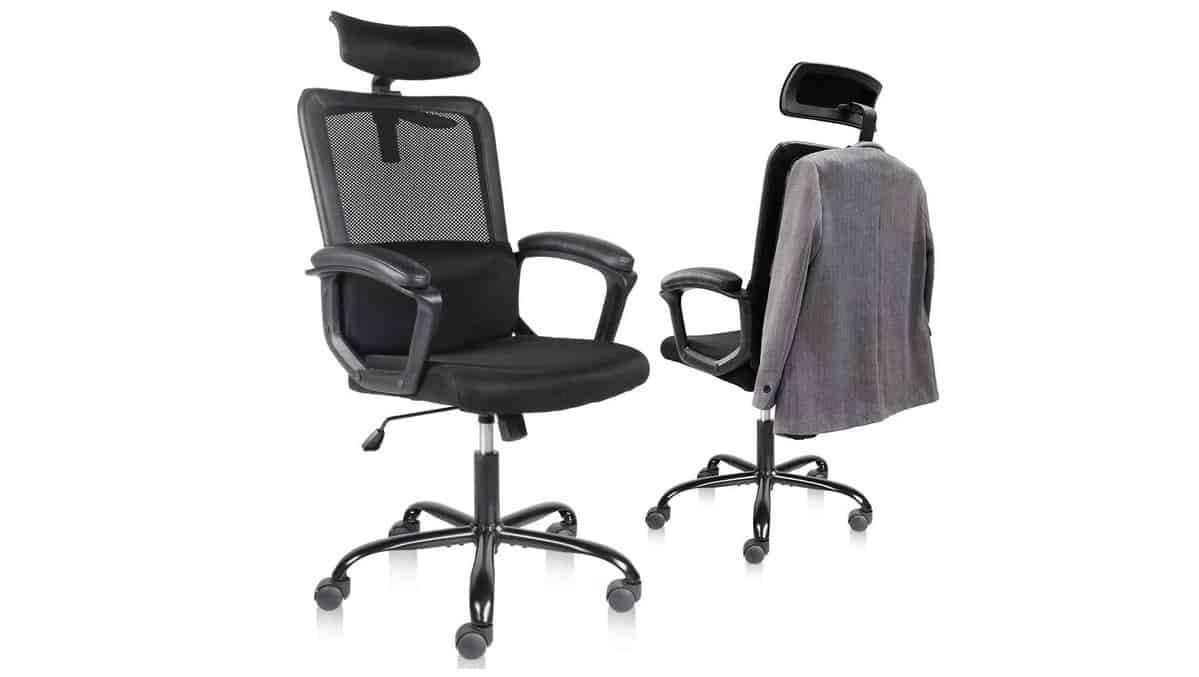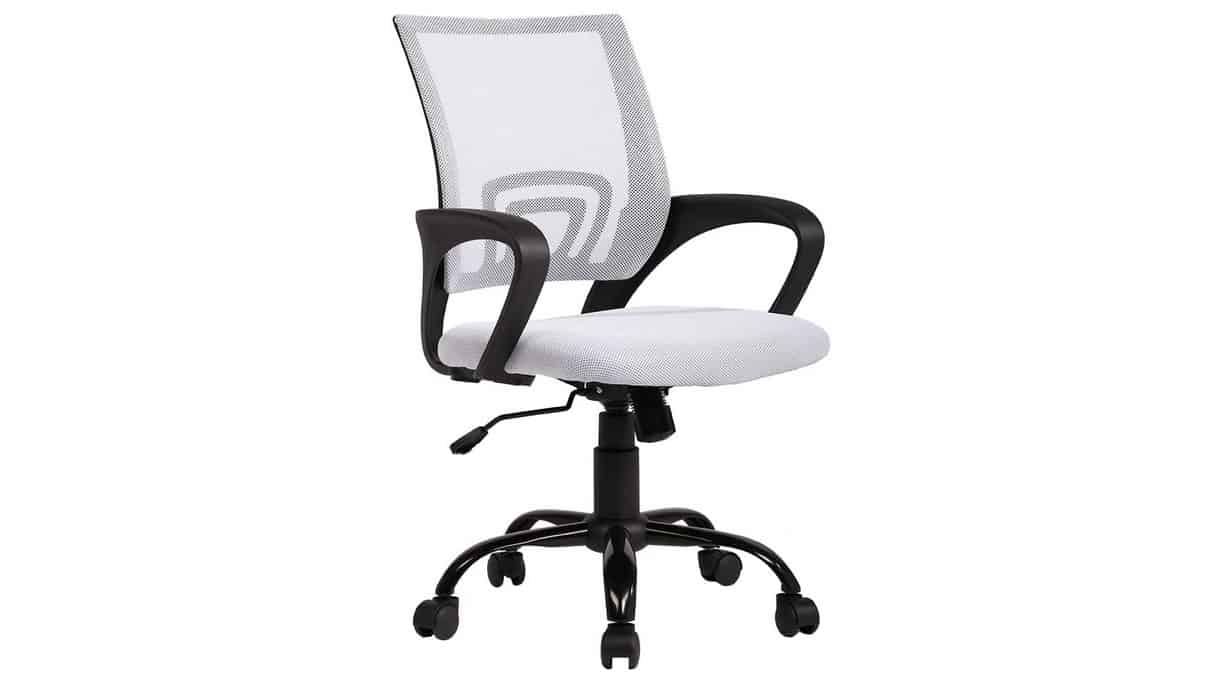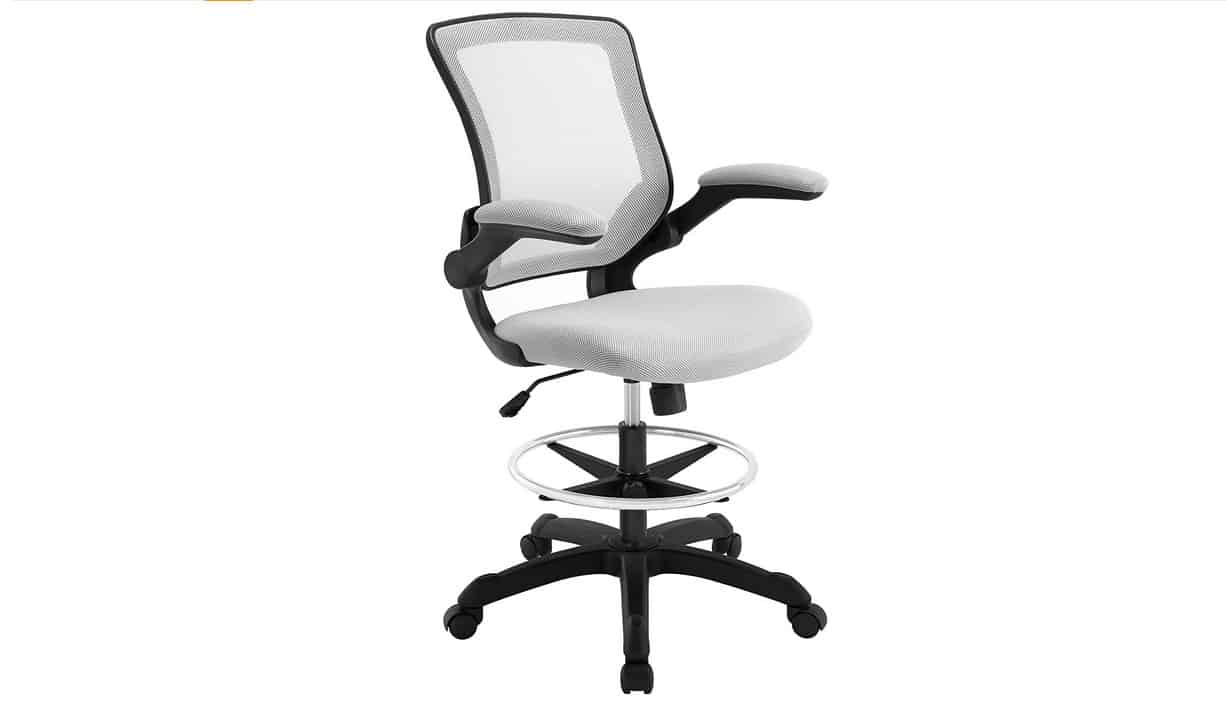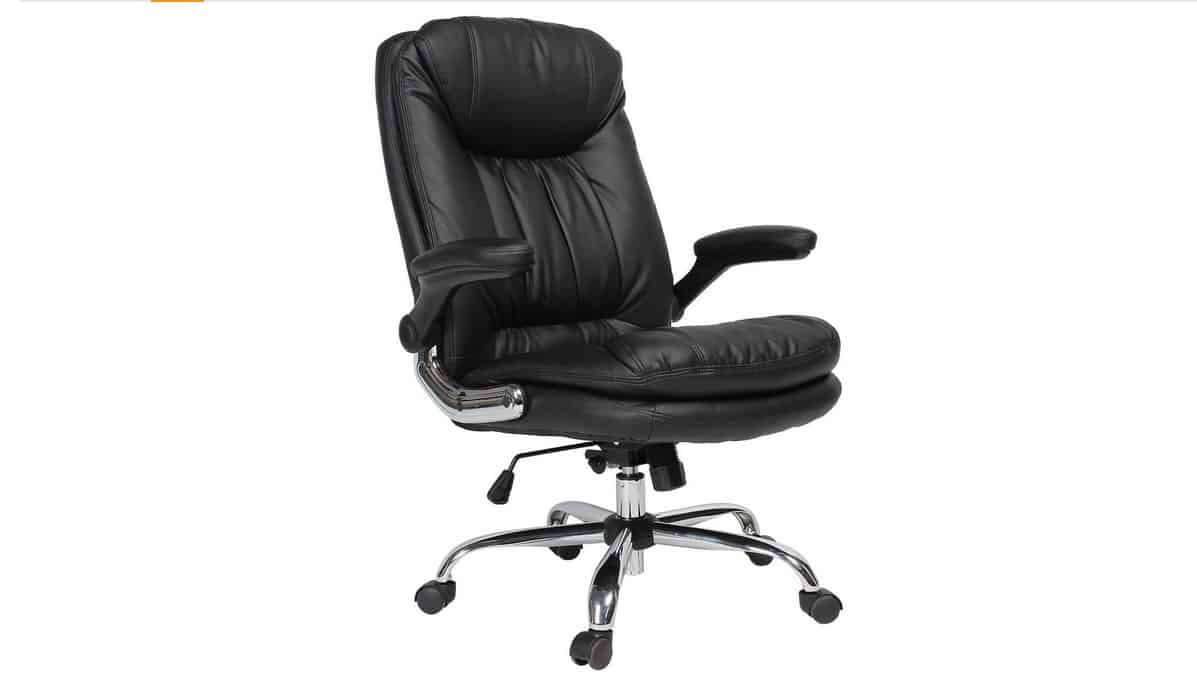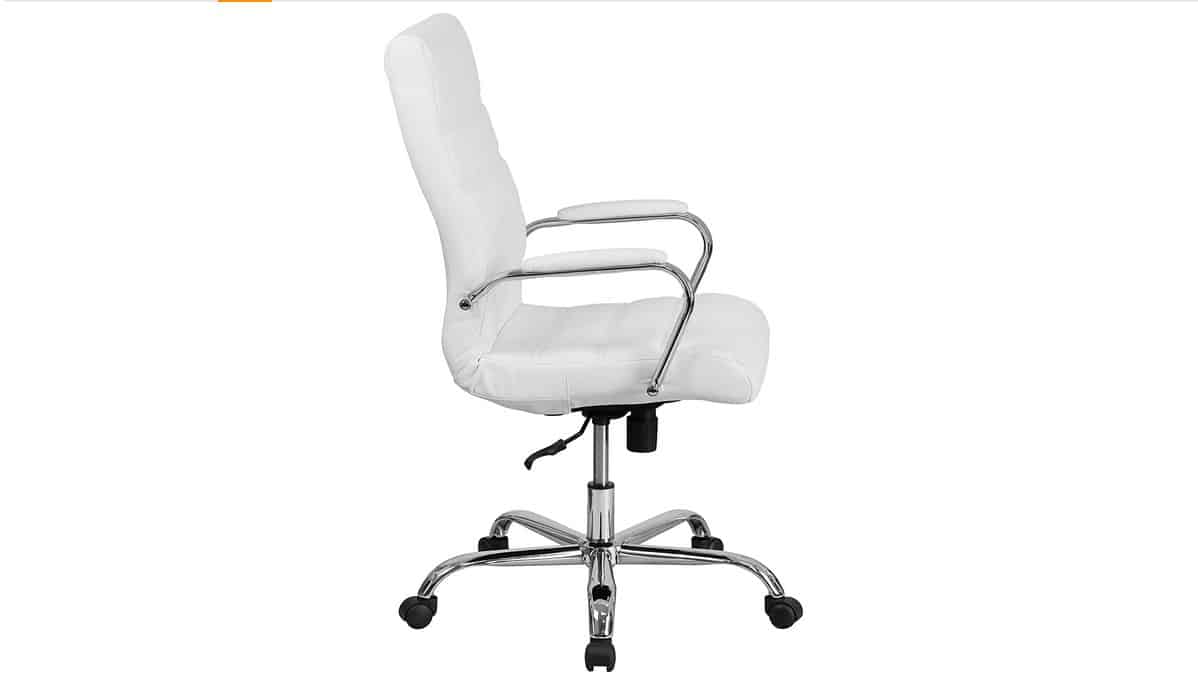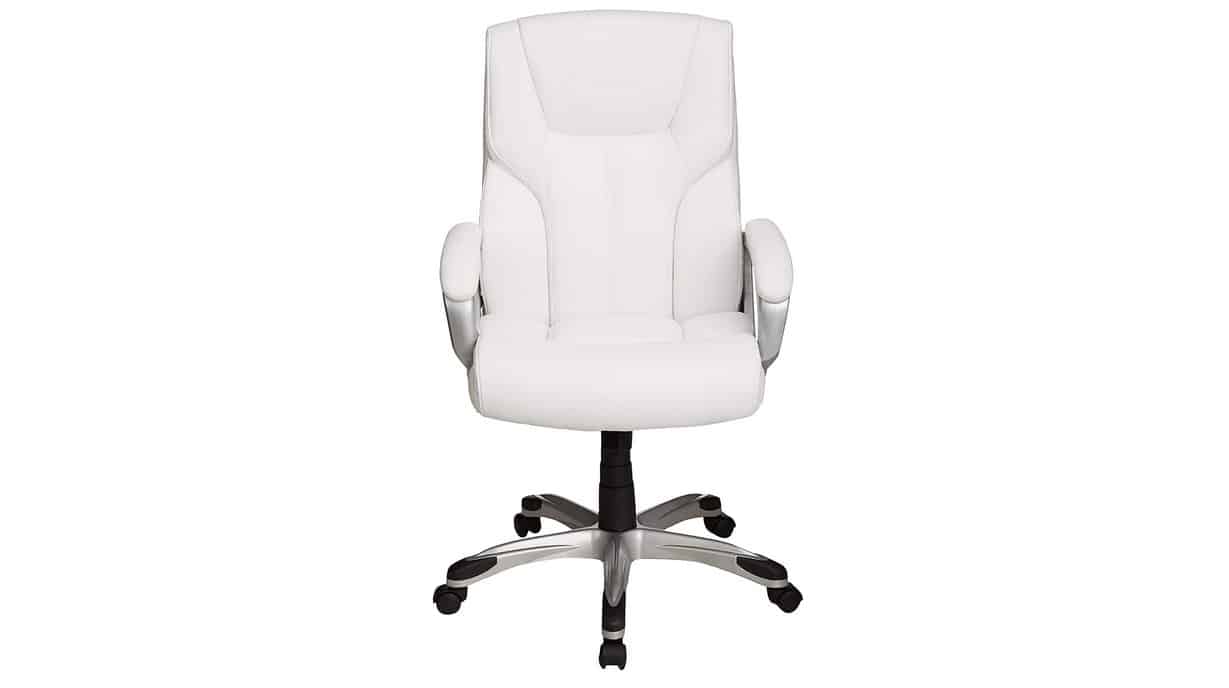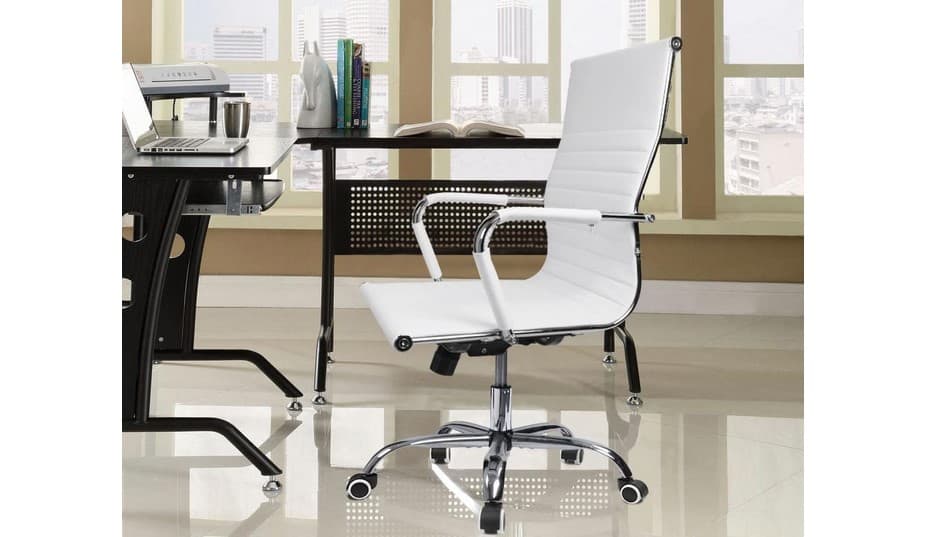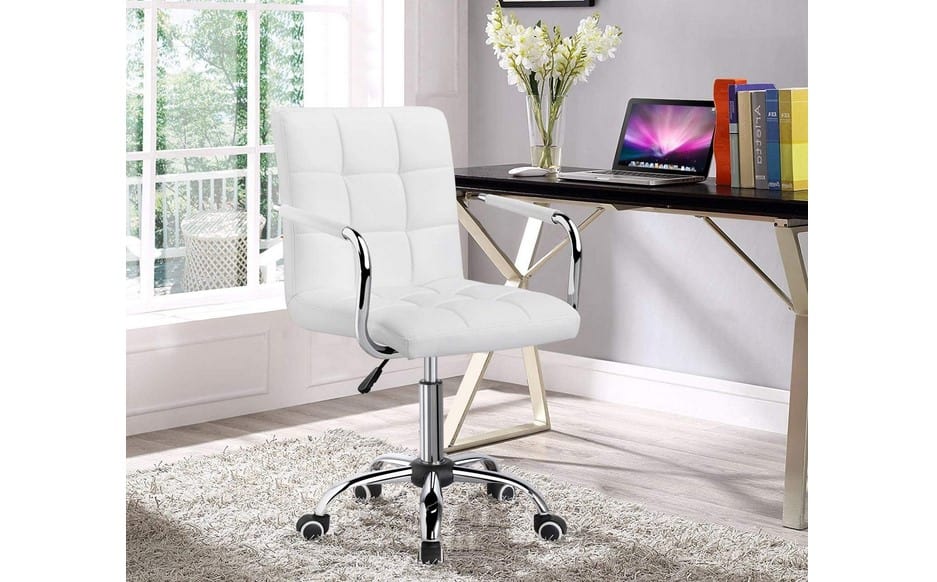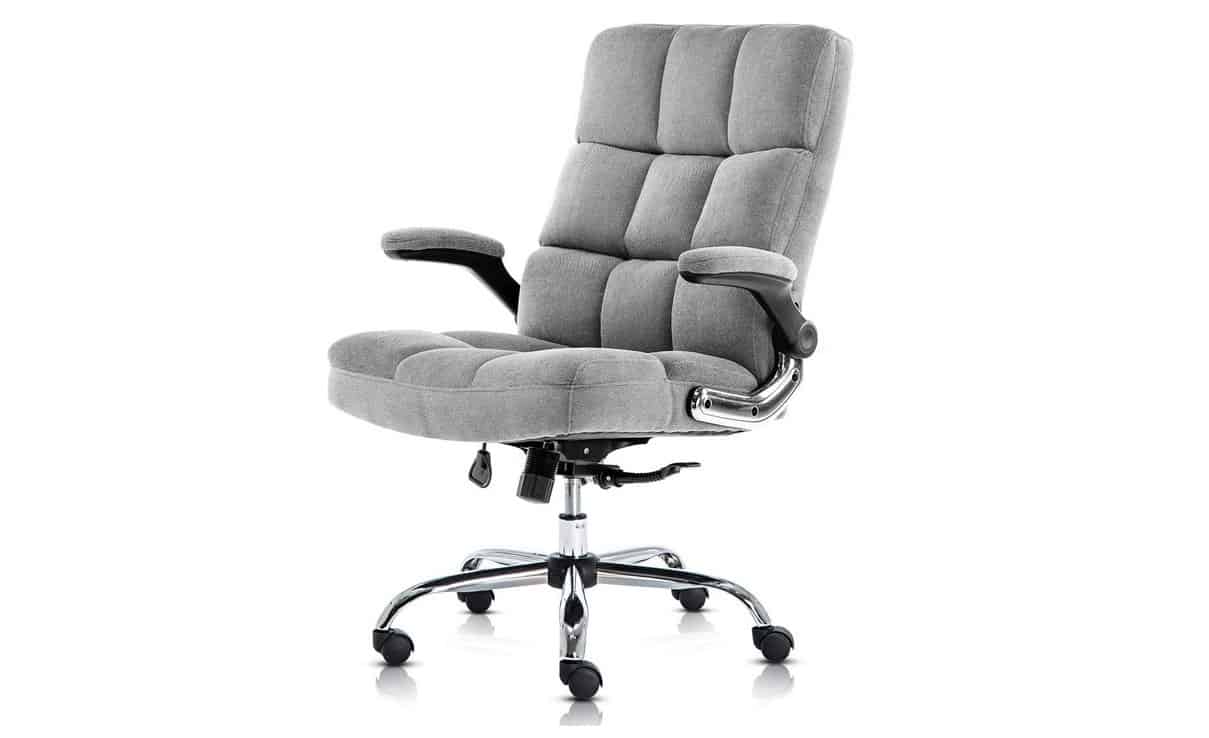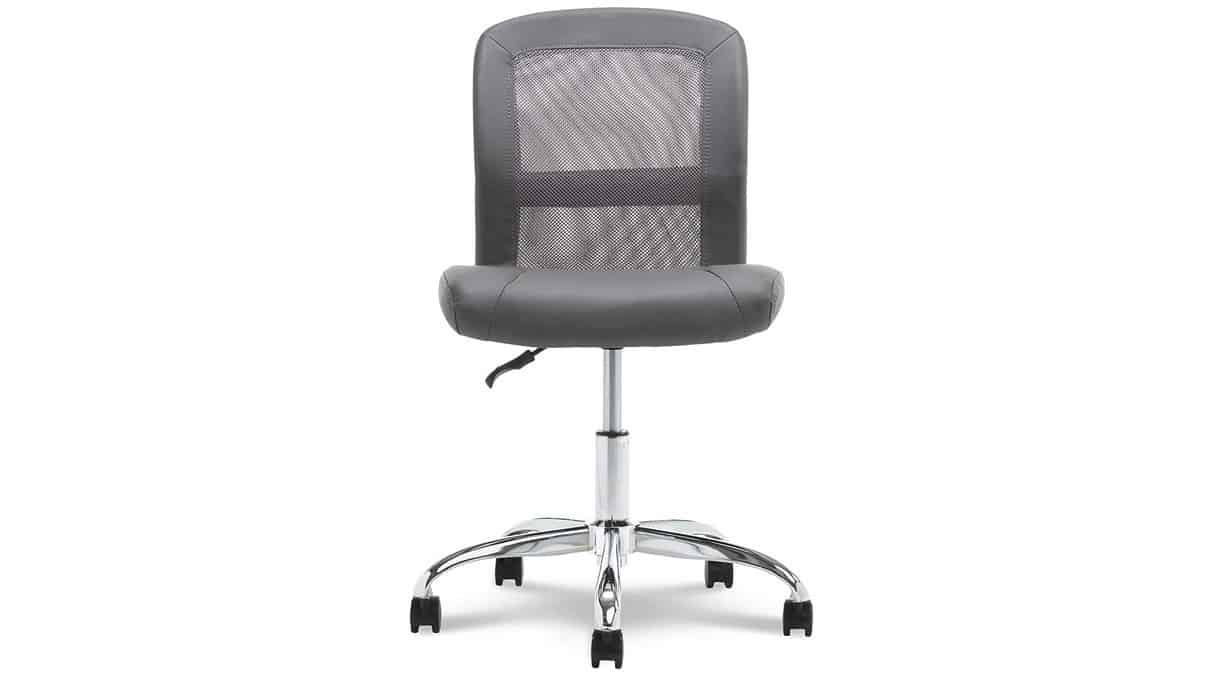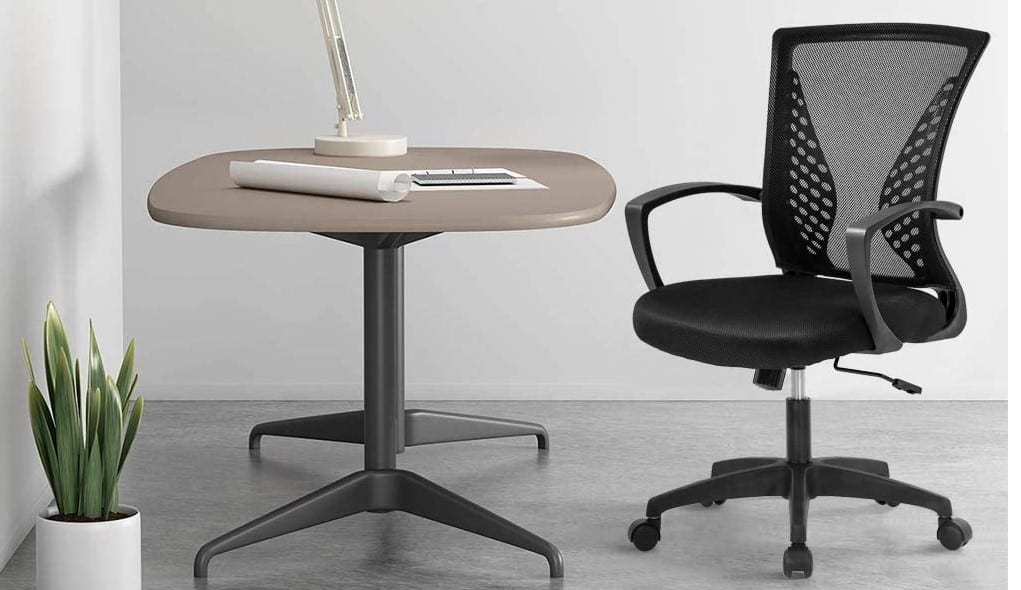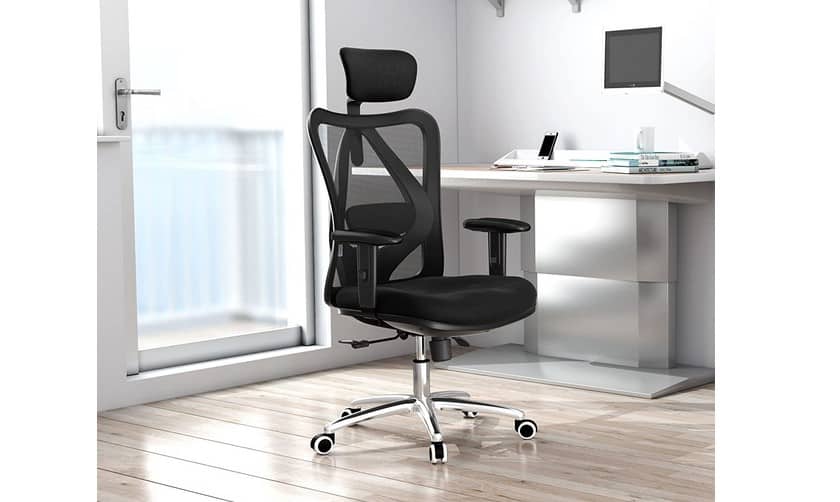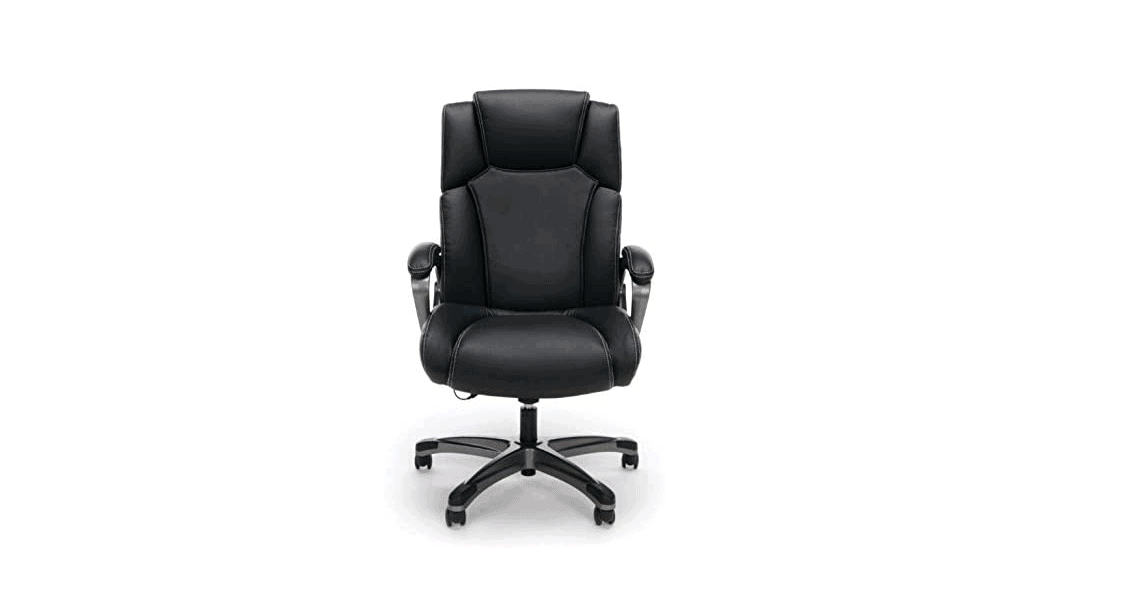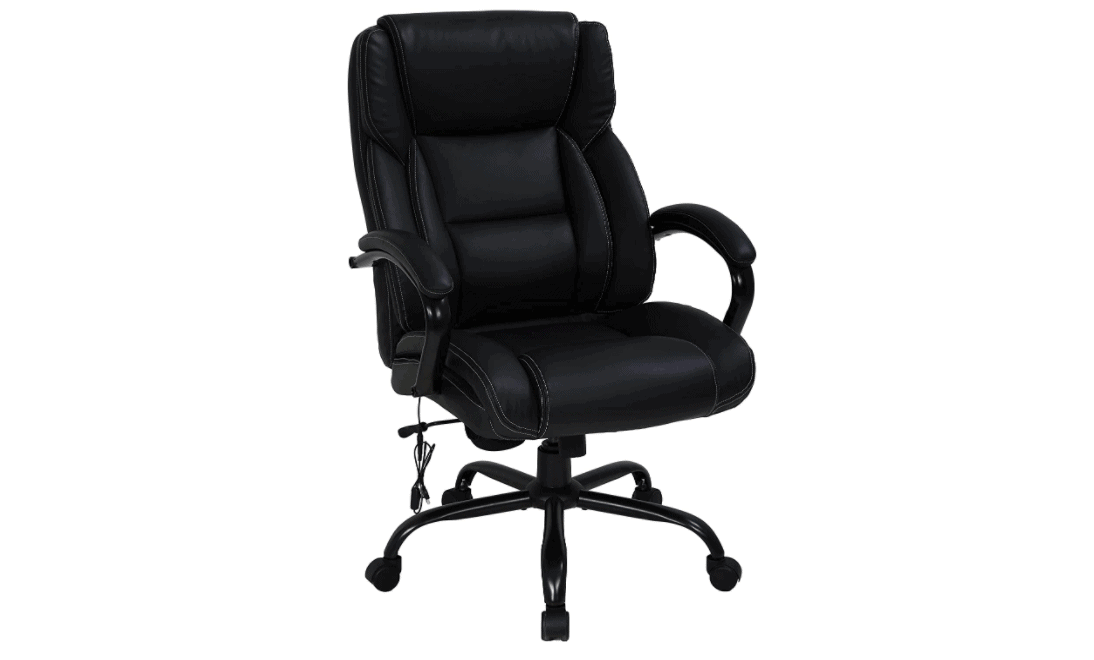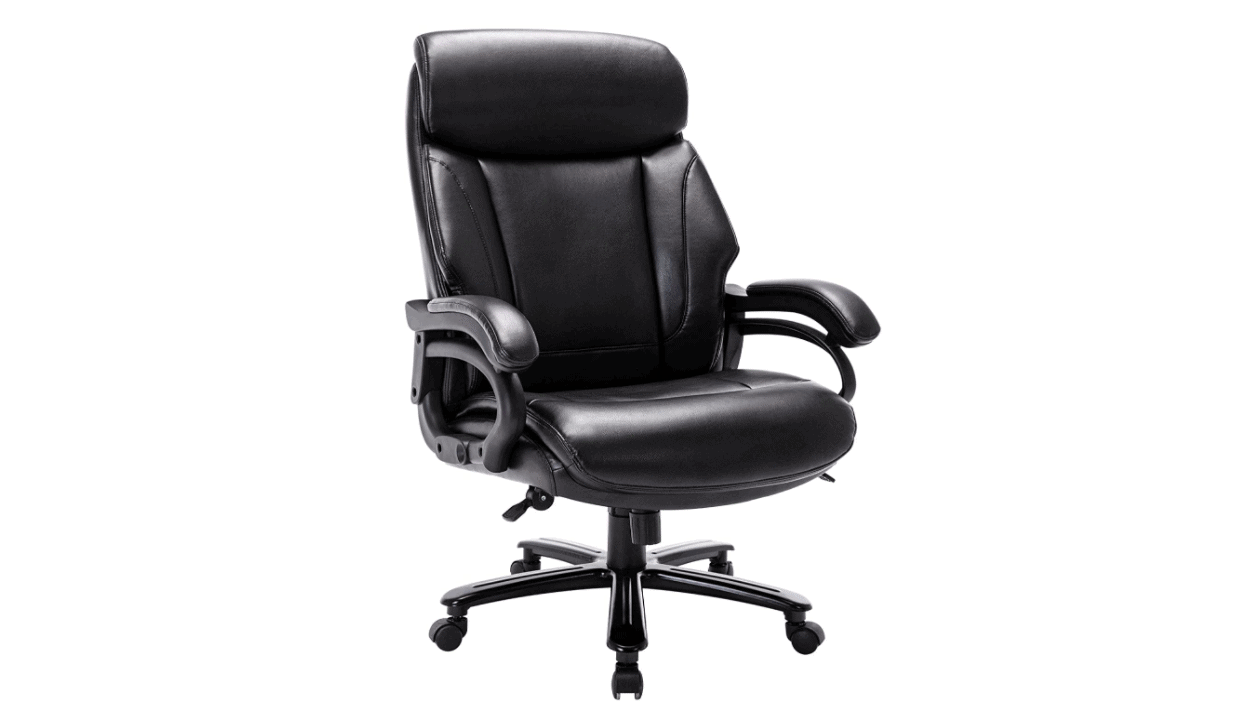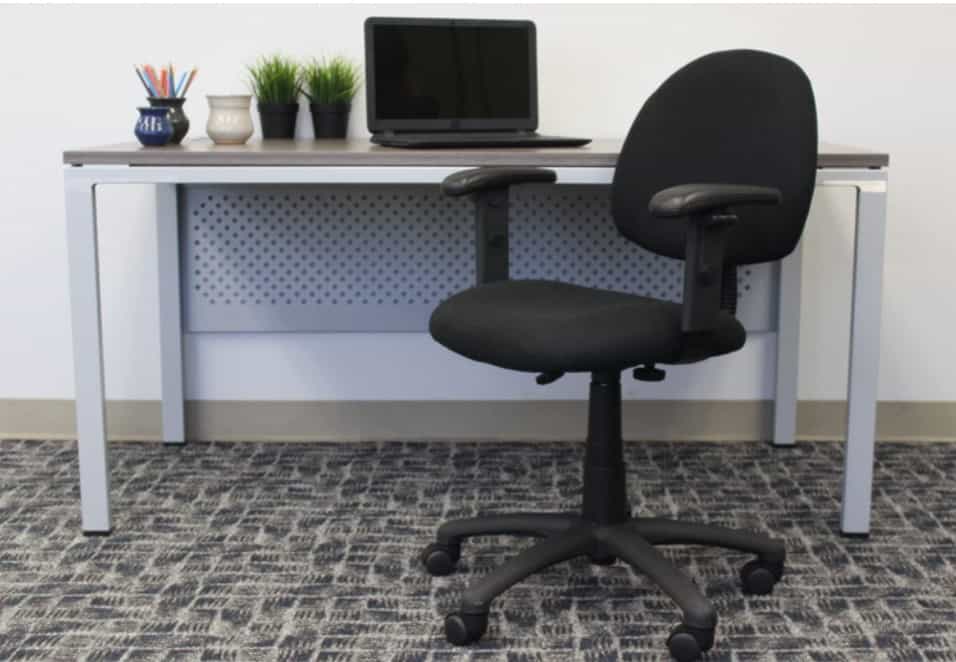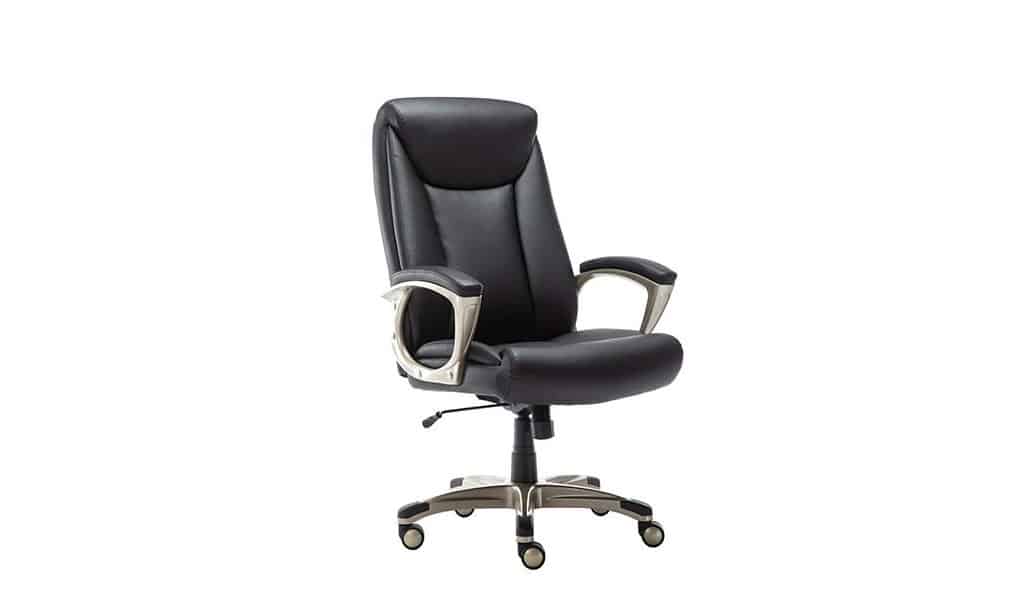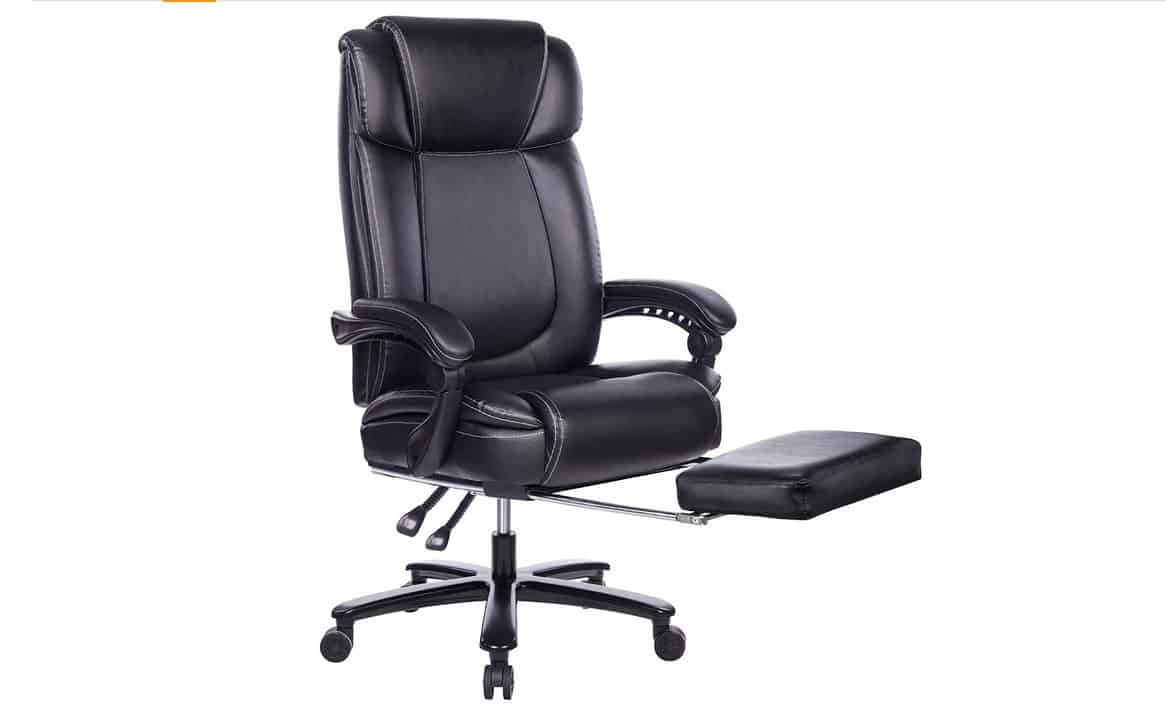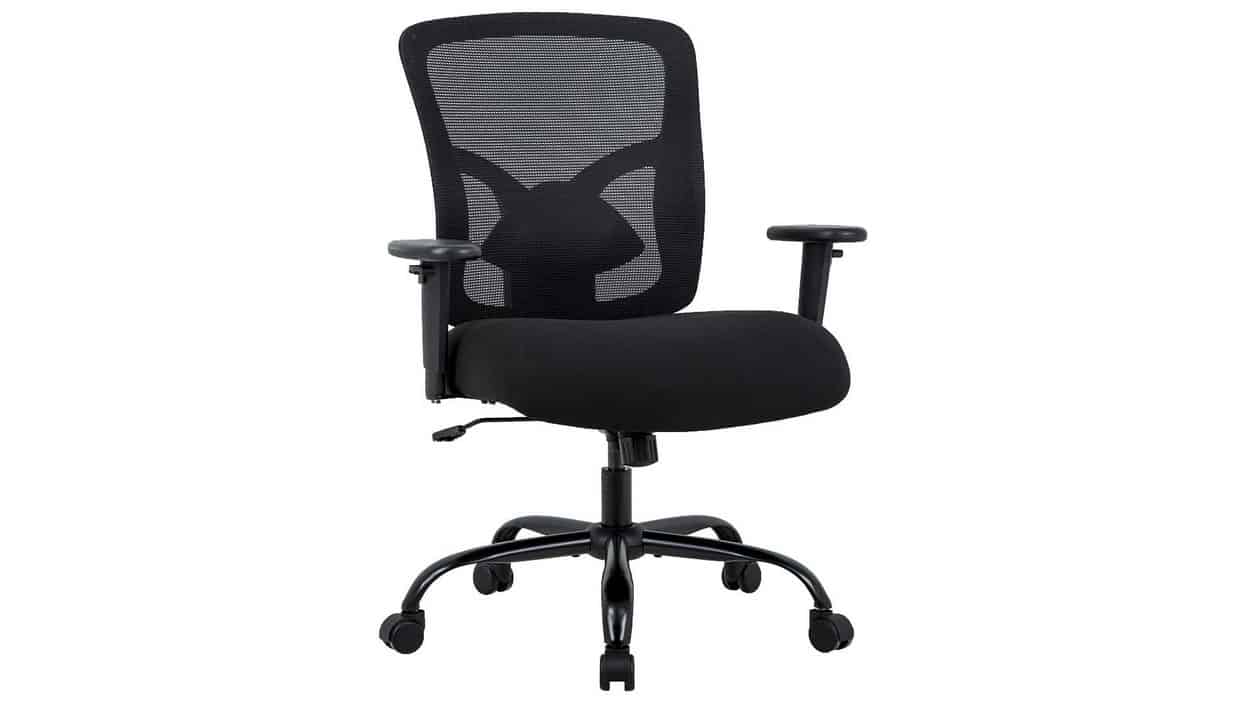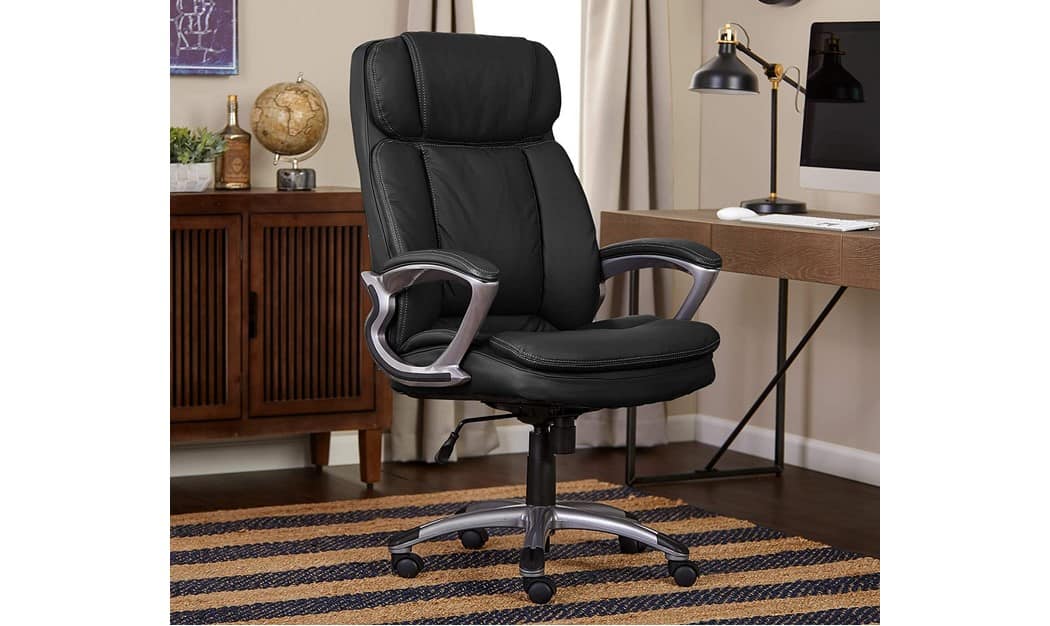When you’re looking for the best office chair for hip pain, that means you need an ergonomically designed chair that provides proper support not just throughout the backrest but also in the seat. You need to look for proper lumbar support that allows for your spine to maintain its natural curve. Additionally, you’ll want an adjustable seat height so that your feet are resting flat on the floor and there’s no uncomfortable pressure created on the backs of your legs.
You might also want to opt for an office chair that features a memory foam seat with a floating tailbone design. This ensures that you aren’t creating painful pressure on your tailbone, which can also be felt in your hips. Additionally, check to verify that the seat is wide enough to comfortably accommodate you, with a depth that allows you to sit comfortably with your back against the backrest. Keep reading our best office chair for hip pain buying guide to learn more.
Top Office Chairs for Hip Pain
#1 Duorest Alpha Dual-Back Home Office Chair
Award: TOP PICK
WHY WE LIKE IT: It has an easily adjustable backrest that is designed to redistribute back pressure and enhance comfort even during movement. Its seat is also made of breathable mesh fabric, and its armrests are also adjustable.
- Excellent dual back backrest
- Has a breathable mesh seat
- Backseat is width adjustable
- Armrests do not have as much padding
The Duorest Ergonomic Office Chair has an innovative dual backrest design to support freedom of movement in any direction. It is designed to alleviate pressure on the backbone while still allowing the spine to maintain its natural shape. The manufacturer claims that its dual backrest design reduces back pressure by up to 44 pounds and also allows users to adjust the width. The ergonomic chair also comes with an adjustable headrest, however, its armrests do not have as much padding.
The seat on this ergonomic chair has a breathable mesh, which is ideal for keeping owners comfortable, especially when sitting for long periods. It can be height adjusted by about five inches, while its headrest can be moved up or down by about 2.8 inches. One of the advantages of its backrest having a dual backrest design is that its width can also be adjusted by about 1.3 inches on either side. The backrest can also be moved up or down by about 1.7 inches or tilted back and set to about four positions thanks to its tilt lock function.
#2 FelixKing Ergonomic Office Chair
Award: HONORABLE MENTION
WHY WE LIKE IT: It has an adjustable back rest, making it ideal for users who have back issues. It is also very easy to assemble, and its armrests are padded and easy to adjust.
- Has adjustable lumbar support
- Very easy to assemble
- Has padded armrests that are easy to adjust
- No headrest
Thanks to its adjustable back support, this ergonomic office chair from the FelixKing store is great for users who might have back problems. Owners will be able to adjust its back support up or down by about 5 cm, and its backrest has a locking mechanism that will have it move back and forth at an angle of about 30°, and with armrests that can be rotated by about 90°, users will also be able to adjust it and have them go right under a table. The chair is also pretty easy to assemble and should take less than 15 minutes to put together. However, it does not have a headrest.
The seat on this chair is made of a high elasticity sponge that is pretty breathable, and it can also be height adjusted by about 8cm. The armrests on this seat are also padded for added comfort, and its backrest consists of a breathable mesh that’ll allow for good air circulation when seated. This chair has smooth-rolling casters that allow it to move quietly around the floor.
#3 Rottnen ErgoGo Ergonomic Office Chair
Award: BEST FOR MOVABLE ARMS
WHY WE LIKE IT: It has a loading capacity of up to 275 pounds and an adjustable backrest that moves according to back movements when seated. Its armrests are fully adjustable and also come with removable padding.
- Flexible lumbar cushion that adjusts according to the seating position
- Armrests come with removable padding
- Has a headrest
- Seat cannot be tilted forward
The Rottnen ErgoRo is an ergonomic office chair with armrests that are both pivot and height-adjustable. They can be moved up or down by about 3 inches, or left and right depending on the need for adjustment. The armrests are also padded for comfort, and their backrest is split into two sections for optimum back support. The seat on this chair is made of breathable mesh fabric, and it also has a waterfall design to enhance blood flow towards the feet. Still, the seat cannot be tilted forward.
This seat has a special synchro-tilt functionality that makes it possible to tilt the seat upwards as the backrest reclines, and thanks to its high-class metal frame, the seat can support a loading capacity of up to 275 pounds. This chair also has silent castors that allow users to quietly move across the floor and a flexible lumbar cushion that adjusts to provide back support in tandem with body and back movements when seated.
#4 Zuerst Ergonomic Office Chair
Award: BEST FOR NECK SUPPORT
WHY WE LIKE IT: It has a headrest that can be moved up or down by about 4.7 inches and tilted back by up to 180°. It has a breathable mesh fabric that helps keep it cool and a high-density foam seat for comfort.
- Headrest can be tilted back and adjusted
- Easy to install
- Backrest has breathable mesh fabric for good ventilation
- Armrests are not padded
The Zuerst ergonomic office chair is an executive-looking office chair with an adjustable headrest for great neck support. The headrest allows for up to six levels of vertical adjustment and can be rotated back by up to 180°. Its backrest has a breathable mesh fabric that keeps users cool and well ventilated and adjustable lumbar support that can be tailored to the user’s needs. However, its armrests are not padded.
The backrest on this chair can be leaned back from 90° to 135° and locked in any position. There’s also a knob that adjusts the chair’s tilt tension and a lever that can adjust the seat’s height up or down for up to 4.7 inches. The high-density foam seat on this chair makes it very comfortable to sit on, and its armrests can be adjusted up and down and locked at six different levels. Putting it together is also pretty easy to do, and with a loading capacity of up to 360 pounds, the chair is great for heavy-set individuals.
#5 Nouhas ErgoTask Draft Ergonomic Office Chair
Award: BEST FOR EASE OF ASSEMBLY
WHY WE LIKE IT: It is very easy to assemble, has an adjustable headrest, and can support a weight capacity of up to 240 pounds. Its backrest is made of a breathable mesh material, and on its back, it also has a coat hanger.
- Very easy to assemble
- Weight capacity of up to 240 pounds
- Comes with a coat hanger
- Lumbar support is not adjustable
The Nouhaus ErgoTask ergonomic chair has an adjustable headrest that can be moved up and down to offer support to the neck regardless of the position of seating, and on its back, the chair has an integrated coat hanger that makes it one of the most unique features it has. The chair also has height adjustable armrests that are covered with a soft grip PU leather material, and its backrest has a breathable mesh to allow for ventilation. The seat can be lifted up or down by up to 3.9 inches, and its heavy-duty nylon wheelbase will enable users to glide around easily with minimal noise. Still, its lumbar support is not adjustable.
Weighing only 33.5 pounds, the chair is pretty easy to assemble and comes in black or grey color. It also has smooth blade wheels that allow users to quickly whizz around the floor and a gas lift that allows users to adjust the seat’s height from a minimum of 18.3 inches to 22 inches. The chair can support a maximum weight of up to 240 pounds, and its backrest can be tilted back by up to 135°.
#6 Duramont Adjustable Ergonomic Office Chair
Award: BEST FOR HIGH LOADING CAPACITY
WHY WE LIKE IT: It has a high loading capacity of up to 330 pounds, and its head and armrests are padded for increased comfort. The chair also has adjustable back support, and its backrest has a breathable mesh for good air ventilation.
- Can support a weight of up to 330 pounds
- Fully adjustable armrests
- Padded armrest and headrest
- Might require some help during assembly
The Duramont Ergonomic office chair is great for heavy-set individuals since it can support a weight capacity of up to 330 pounds. It also has a padded headrest for added comfort, and its backrest has a breathable mesh material that allows for good airflow and ventilation. The chair’s armrests are also fully adjustable, and they also come with a bit of padding to make them comfortable. Users who have back pain issues will be happy to hear that the chair also has adjustable lumbar support, but its large size and 44.6-pound weight might warrant some help during assembly.
This chair’s backrest has an ergonomic design that’ll have it adapt to the shape of the user’s back, and it can also be tilted all the way back from 90° to 120°. It also has rollable caster wheels that allow for smooth and quiet movement across the floor, and its seat cushion has a waterfall design to facilitate blood flow to the legs and prevent excessive tiredness for users who tend to sit around for extended periods.
Beginner’s Guide to Office Chairs for Hip Pain
What is an Office Chair for Hip Pain?
If you sit for extended periods, it’s easy for the pain to develop. In particular, with office chairs where you’re working at a desk — often with your arms up at a 90-degree angle typing on a computer or writing on paper — you may find that you get pain that occurs in your neck or shoulders, back, and hips.
To help alleviate this discomfort, you need an ergonomically designed chair. Office chairs designed specifically to address hip pain are usually ergonomic. This means that they feature a few specific characteristics intended to help evenly distribute your weight across your body — including some of the best wooden office chairs.
First, they feature proper lumbar support. Whether built-in or adjustable, these chairs allow your spine to maintain its natural curve. Premium chairs will offer lumbar adjustments meaning that you can raise or lower and increase or decrease the depth of the backrest support so that it’s customized to your needs.
Next, you’ll want an office chair with an adjustable height feature. This is fairly standard across office chairs of all price points. The adjustment range can vary, with some chairs only offering two to three inches of height adjustments and others providing as much as 10 inches. This will also depend on the type of desk you’re using. People with drafting tables or standing and adjustable desks may want a larger range to accommodate the table.
You’ll also want to pay attention to the seat quality. In particular, with hip pain, you want a supportive seat that helps to distribute your weight properly. But at the same time, you need a chair that’s an accommodating width compatible with your dimensions.
Often, hip pain isn’t an isolated scenario and can accompany other aches like tailbone pain. So, look for a seat with a floating tailbone cushion design. This means that the cushion features a u-shape which helps to reduce pressure on your tailbone and provides additional support in the hips. Also, chairs intended to reduce hip pain may feature adjustable seat angles, allowing you to find the perfect position that allows your knees to rest at a 90-degree angle with your feet firmly on the floor.
Regardless of the chair, you select, you should be able to maintain the following posture comfortably. Your back should rest comfortably against the backrest without disturbing the natural curve of your spine, and your feet should be flat on the floor with your knees at a 90-degree angle. At the same time, you should be at a height with your desk where your arms are parallel to the tabletop, with elbows bent at a 90-degree angle. Finally, you should be able to maintain a neutral posture with your head parallel to your desktop.
Note that many of the same features necessary for alleviating hip pain can also be found in the best office chairs for sciatica.
Office Chairs for Hip Pain vs. Other Office Chairs
In truth, most office chairs are designed to be ergonomic. This means that it’s pretty rare to find a chair marketed specifically as an office chair that lacks lumbar support and a supportive cushion. However, the biggest difference between a chair designed for hip pain and a generic or basic office chair is the customization.
As we mentioned, the two core features almost every office chair has in common are lumbar support and seat height adjustment, unless it’s a stationary office chair. However, additional options like adjustable lumbar support, seat angle customization, and even options like adjustable or flip-up armrests are not standard.
And in some cases, like with Herman Miller chairs, you can even select one that’s customized to your weight and height. This allows you to find a chair that’s truly designed for you and will help to minimize the discomfort normally experienced with sitting for sustained periods.
How Office Chairs for Hip Pain Work
Office chairs for hip pain are designed to be ergonomic. But in general, virtually every office chair features similar functionality to help provide support for your back and legs. Usually, your chair will have a backrest and a seat cushion.
The backrest will offer built-in lumbar support, while the cushion will usually have a waterfall edge designed to reduce pressure on the back of your legs. In addition, some cushions will feature responsive memory foam, which helps support your hips and evenly distribute weight.
For chairs set on casters, you can also expect to get seat height adjustment. By raising or lowering a lever located under the seat cushion, you can adjust the height to your needs. Additionally, many office chairs also feature additional levers to support tilt/rock or recline functions and, in some cases, a lever to adjust the seat pitch which controls the seat angle. Chairs with wheels will usually also include 360-degree swivel functionality.
Not all office chairs feature armrests — and not everyone wants them. But with armrest chairs, there are two options, adjustable or fixed. Fixed armrests are exactly as they sound and cannot be customized. The drawback of this is that you might feel constricted by the armrests. In some cases, it’s incompatible with your desk height, forcing you to place the seat further back so that the armrests don’t bang into the desk.
Adjustable armrests can include flip-up armrests, which are nice because you can move them out of the way when you need to. But in other scenarios, you might find armrests that can also be shifted in and out or raised and lowered. The benefit of this is that you can adjust the armrests, so you aren’t constricted and so that they don’t interfere with your desk.
And finally, some office chairs come with headrests. A headrest can be a nice function if you want to ensure that your back is always comfortably against the backrest. Sometimes this feature is adjustable so that you can raise or lower the headrest or angle it to a more comfortable position.
Why You Should Buy an Office Chair for Hip Pain
Prioritizing bodily comfort, especially for people who sit for extended periods, is essential. Sitting for prolonged periods can increase your risk of developing neck, back, buttock, and hip pain. Over time, this can lead to scenarios such as experiencing sciatica or creating lifelong discomfort.
Are Office Chairs for Hip Pain Worth Buying?
- You Work at a Desk All Day: The average workday is eight to nine hours, meaning you can log 40 to 45 hours a week sitting at a desk. If you’re not maintaining proper posture or using a makeshift chair that isn’t supportive, you can worsen a bad situation.
- You Have Neck, Back, or Hip Pain: If you’ve already been diagnosed with neck, back, or hip pain, you should be prioritizing an ergonomically designed chair. While a good office chair can’t cure existing pain, it can help to reduce fatigue that can exacerbate your body.
- You’re Pregnant: Pregnancy is an amazing experience, but it’s also a time when women are more likely to experience unexpected aches and pains — including sciatica, hip, and back pain — because of increased hormones impacting ligaments and joints. If anyone needs more support, it’s pregnant women.
Why Office Chairs for Hip Pain May Not Be for You
- You Don’t Work at a Desk: If you work in a job where you’re standing all day, you don’t need an office chair. Instead, supportive footwear might better serve you.
- You Don’t Have Hip Pain: Office chairs designed for hip pain are just ergonomic office chairs. But if you don’t have hip pain, this might not be a concern for you.
- You Have Other Pain Concerns: Maybe there’s another part of your body that’s causing your aches and pains. While an office chair intended for hip pain might help them, it might not have the comprehensive support you need for what ails you.
How Long Will Office Chairs for Hip Pain Last?
Office chairs tend to be a durable product category that can last for several years. While individual mileage will vary, you can easily get five to eight years of regular use out of an office chair before it needs to be replaced. Of course, this timeline assumes that you’re sitting in it eight hours a day, five days a week, for 40 hours.
However, some factors will increase or decrease the longevity of your office chair. First, consider the build quality. Chairs made from cheaper materials or thinner cushioning are more likely to break from routine wear and tear faster. Likewise, a cheap or thin cushion will go flat fairly quickly and require a more frequent replacement.
You’ll also want to consider user error and how that might impact the chair’s lifespan. For example, if you’re rough on the components and gruffly adjust the seat height or abuse the tilt/rock or recline feature, you can’t expect the chair to last. Additionally, using a chair that’s not rated to support your weight can also cause premature product failure.
However, many chairs are sold with limited warranties ranging from one to 10 years. The warranty can give you an idea of how long the chair should last with normal use before you might want to consider replacing it.
How to Choose the Best Office Chairs for Hip Pain
Support and customizations are going to be the two biggest factors driving your purchasing decisions if you’re shopping for an office chair to help minimize hip pain. While the budget does matter, it shouldn’t be the first factor, as this can leave you with a chair that will not provide the support you need.
Office Chairs for Hip Pain Key Factors to Consider
1. Do you want a wheeled or stationary office chair?
Not everyone loves office chairs that are set on wheels. If this sounds familiar, you’ll need to look for a supportive chair that is stationary. The only drawback is that it’s less common to find stationary chairs that also feature height adjustment.
When you do, these are usually known as active chairs, which engage your core. While this is nice if you work at a taller desk, the downside is that active chairs usually don’t have backrests and are more like stools. Additionally, you can also opt for a balance ball chair. These chairs are intended to help properly distribute your weight while providing responsive support to your body where it needs it and engaging your core simultaneously.
2. Is the lumbar support adjustable?
Don’t underestimate the importance of lumbar support. If your back is out of alignment, it can create painful pressure points throughout other areas of your body, including your hips. So at a minimum, any office chair you consider should have built-in lumbar support. But if you’re concerned about getting the support that’s “just right,” look for chairs that feature adjustable lumbar support.
3. Is the seat height range compatible with your desk?
Along with lumbar support, a seat that’s too high or low compared to your desk can also cause pain in your hips. Ideally, you should be able to adjust your office chair height so that you’re able to sit with your feet flat on the floor, knees, and hips at a 100- to 110-degree angle (meaning that you’re sitting in a slightly reclined position), and with your arms parallel to your desktop.
For best results, measure your desktop height before shopping for a chair. This ensures that you can eliminate chairs with height adjustment ranges that are incompatible or stationary chairs that are too high or low.
4. Can you adjust the seat angle?
One of the biggest causes of hip pain from office chairs is sitting in a chair where your hips are angled improperly. Having access to seat angle adjustments guarantees that you can ensure proper hip alignment while sitting. However, this feature comes at a premium as seat angle or pitch adjustments aren’t a standard feature and are usually reserved for premium seating solutions.
5. Do you want a reclining chair?
Most wheeled office chairs and many stationary chairs have some type of tilt or rocking motion. But in other cases, you can find chairs that provide a true recline function. Consider how deep of a recline you prefer. At a minimum, some chairs can recline up to 120 degrees, with others offering deeper ranges — as much as a lay-flat 180-degrees. However, if you opt for recline ranges between 150 degrees, it’s a good idea to ensure that there’s a footrest, so you’re not putting unnecessary pressure on your hips and legs.
6. What chair design do you prefer?
Office chairs come in a variety of designs, making it possible for you to select a chair that complements your commercial or residential office space. The most common option is the mesh combination chair. This chair has a ventilated mesh backrest and an upholstered seat cushion. Typically, the seat cushion is covered in fabric, but it can also be leather.
Alternatively, you can opt for a leather upholstered chair, often known as an executive chair. These chairs have a more luxe image but are usually less breathable. And finally, you can choose a gaming chair. While these chairs traditionally have an overstuffed appearance, they’re also usually the most supportive.
7. What is the weight capacity?
The fastest way to prematurely damage a chair is by using one that isn’t compatible with your weight. It is possible to find chairs designed for big and tall customers. Usually, this means that the chair supports more than 300 pounds. And sometimes you can find chairs with weight ratings up to 450 pounds.
8. Do you want armrests?
As we’ve mentioned before, not everyone likes armrests. If you don’t want them, there are plenty of supportive options that don’t have armrests. But if you like the idea of armrests but also enjoy not having them, flip-up armrests are the way to go. And if you like armrests but want the option to adjust them, look for models with adjustable armrests.
9. What is your budget?
Just like any other product category, office chairs come with a wide price range. While even low-budget chairs promise lumbar support and a cushioned seat, you might want to ignore those and splurge on an upgraded solution if you have serious hip pain.

![Best Office Chairs for Hip Pain in [year] 1 best office chair for hip pain](https://www.gadgetreview.dev/wp-content/uploads/best-office-chair-for-hip-pain-image.jpg)


![Best Office Chairs for Hip Pain in [year] 2 【Dual-Backrests】 Alpha - Ergonomic Office Chair,...](https://m.media-amazon.com/images/I/41i83w76QfL._SL160_.jpg)
![Best Office Chairs for Hip Pain in [year] 3 FelixKing Office Chair - Ergonomic Desk Chair with...](https://m.media-amazon.com/images/I/41Z8ML7y5IL._SL160_.jpg)
![Best Office Chairs for Hip Pain in [year] 4 Rottnen ErgoRo Ergonomic Office Chair-Rolling Desk...](https://m.media-amazon.com/images/I/41jDwIMfeYL._SL160_.jpg)
![Best Office Chairs for Hip Pain in [year] 8 Our #4 Pick is the Zuerst Ergonomic Office Chair](https://m.media-amazon.com/images/I/31wcJzvBRiL._SL160_.jpg)
![Best Office Chairs for Hip Pain in [year] 9 Our #5 Pick is the Nouhas ErgoTask Draft Ergonomic Office Chair](https://m.media-amazon.com/images/I/31krh9GYalL._SL160_.jpg)
![Best Office Chairs for Hip Pain in [year] 10 Our #6 Pick is the Duramont Adjustable Ergonomic Office Chair](https://m.media-amazon.com/images/I/41XozT+Ih2L._SL160_.jpg)


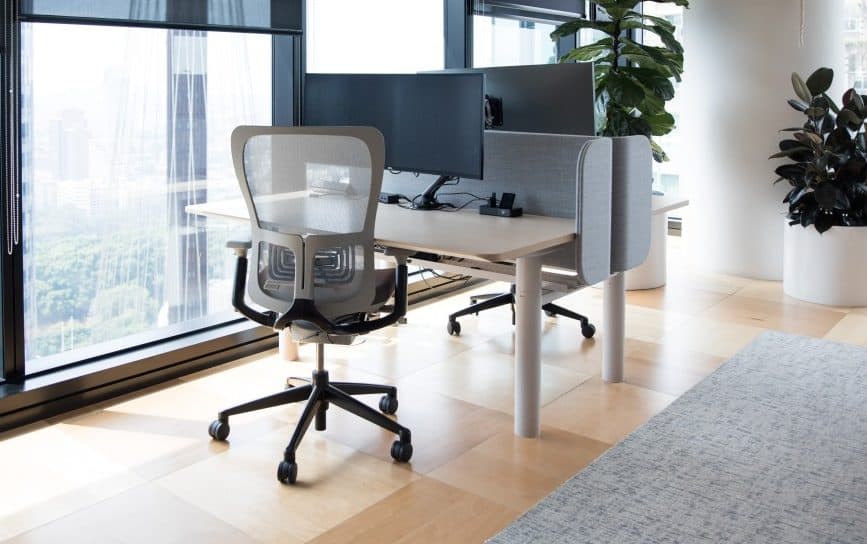
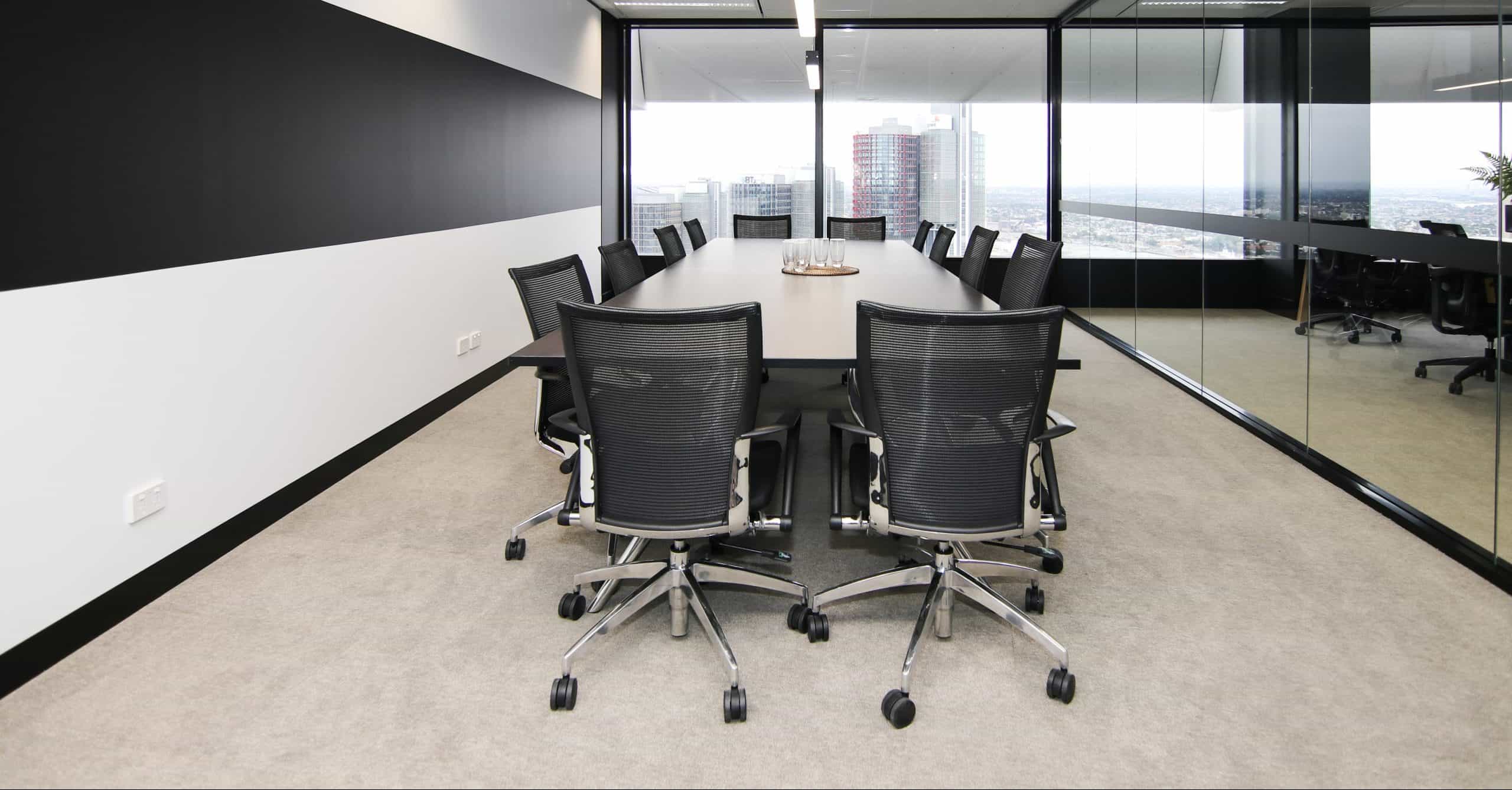
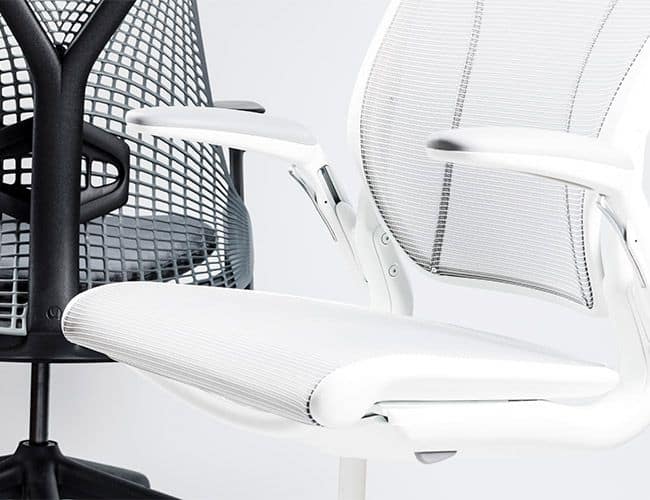
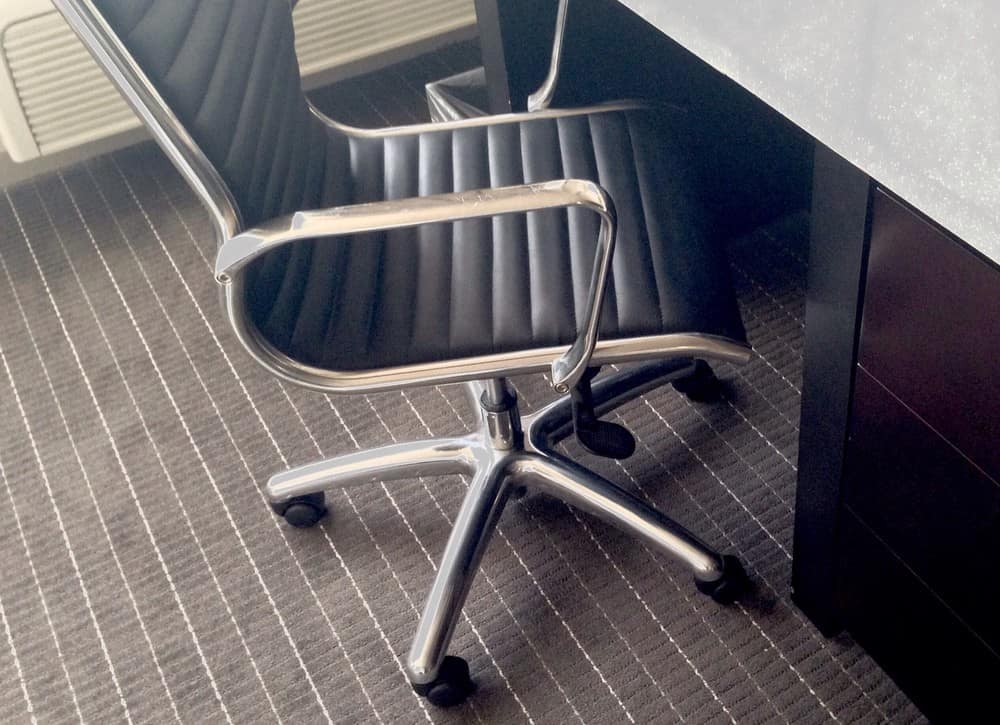


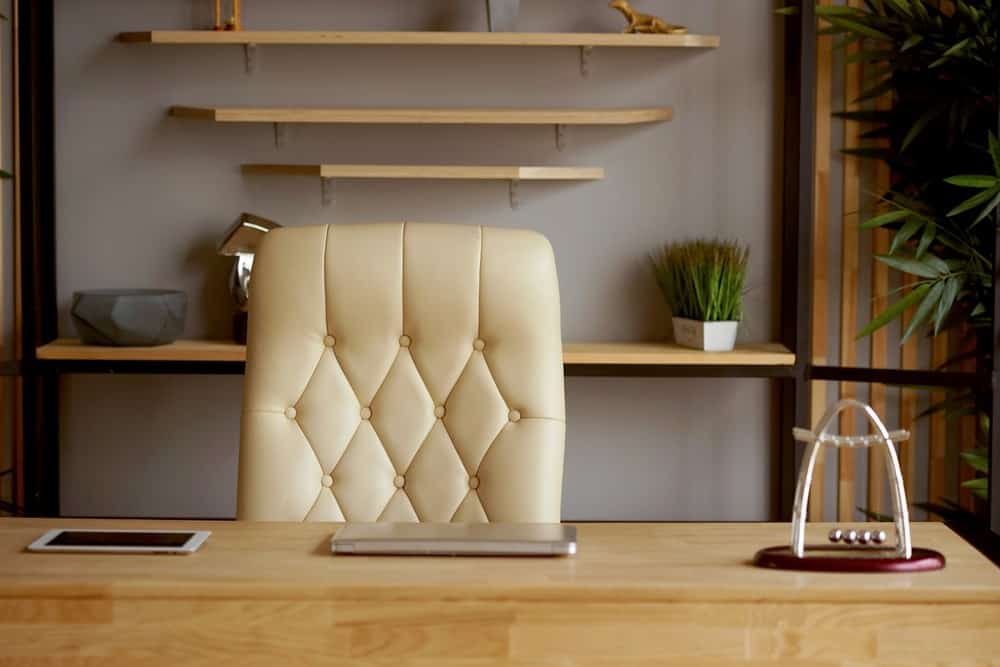
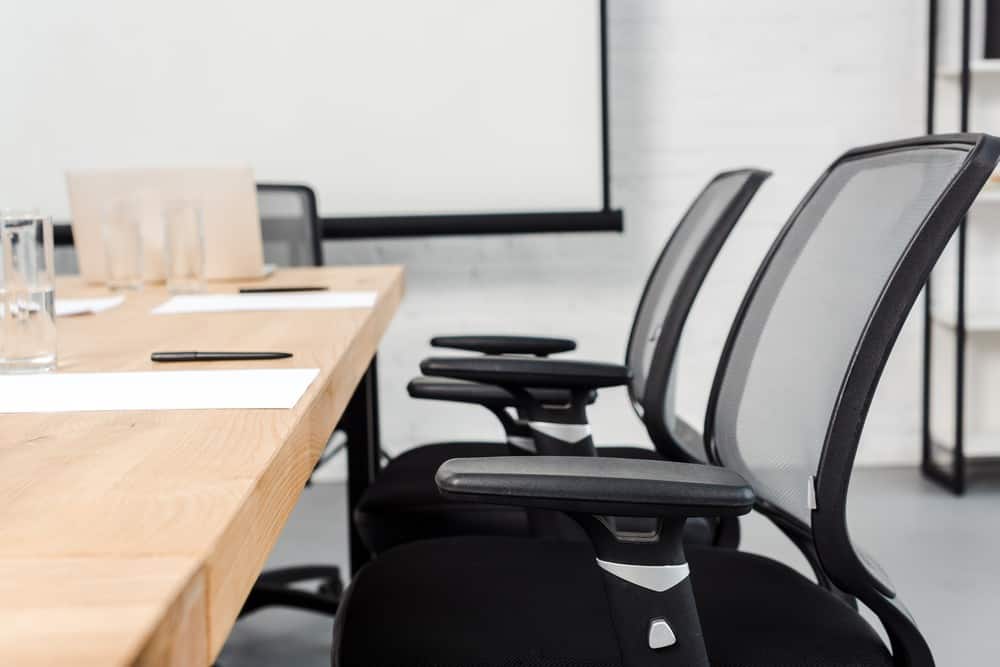


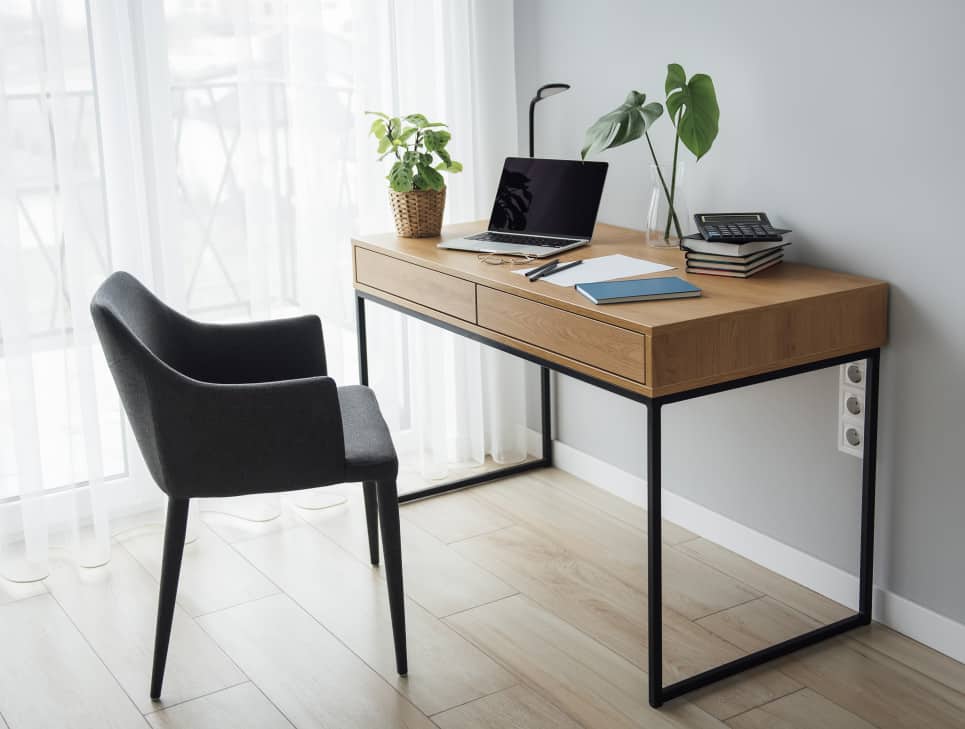


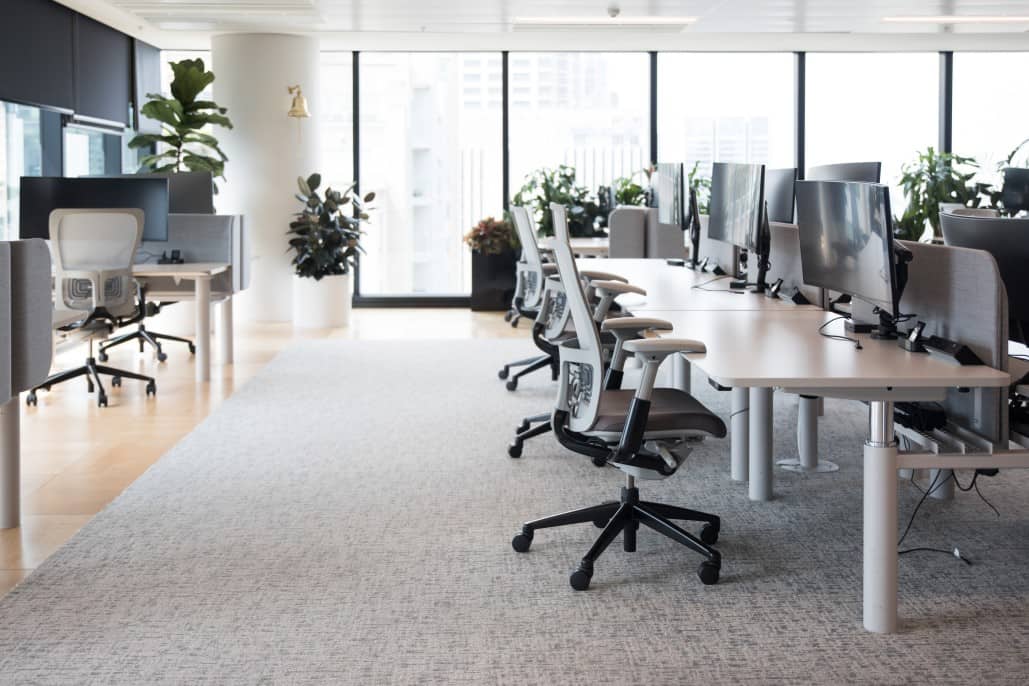
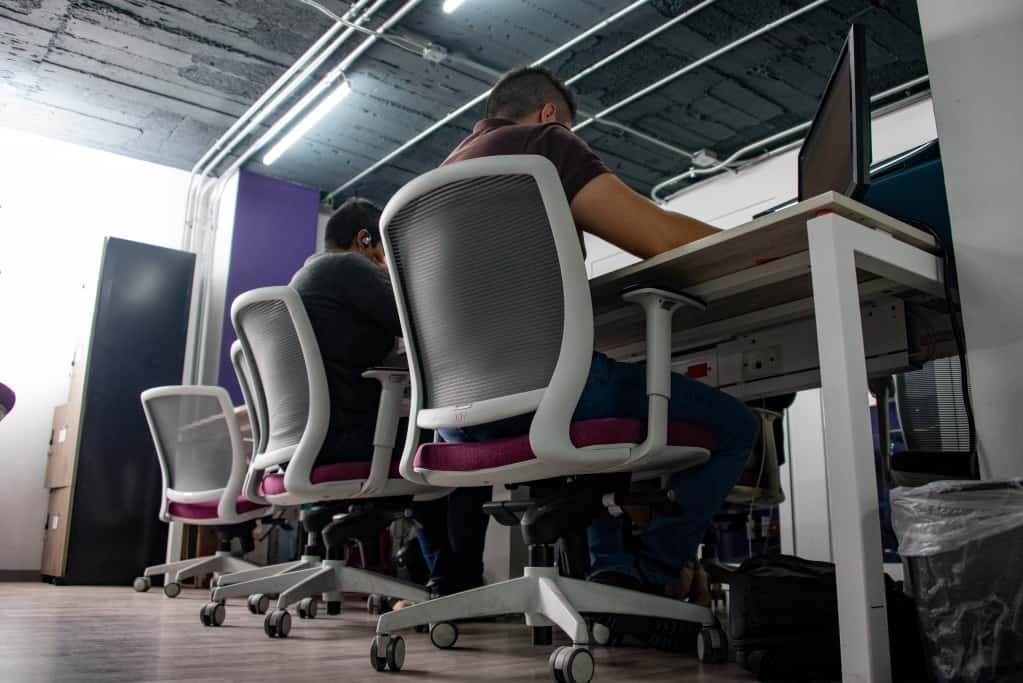
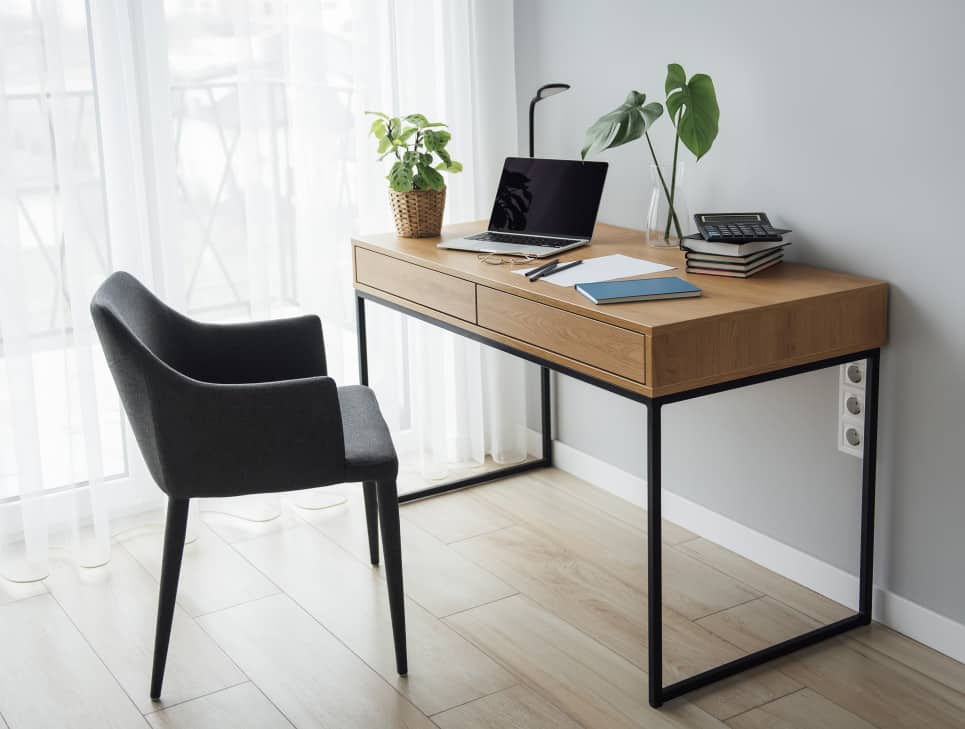

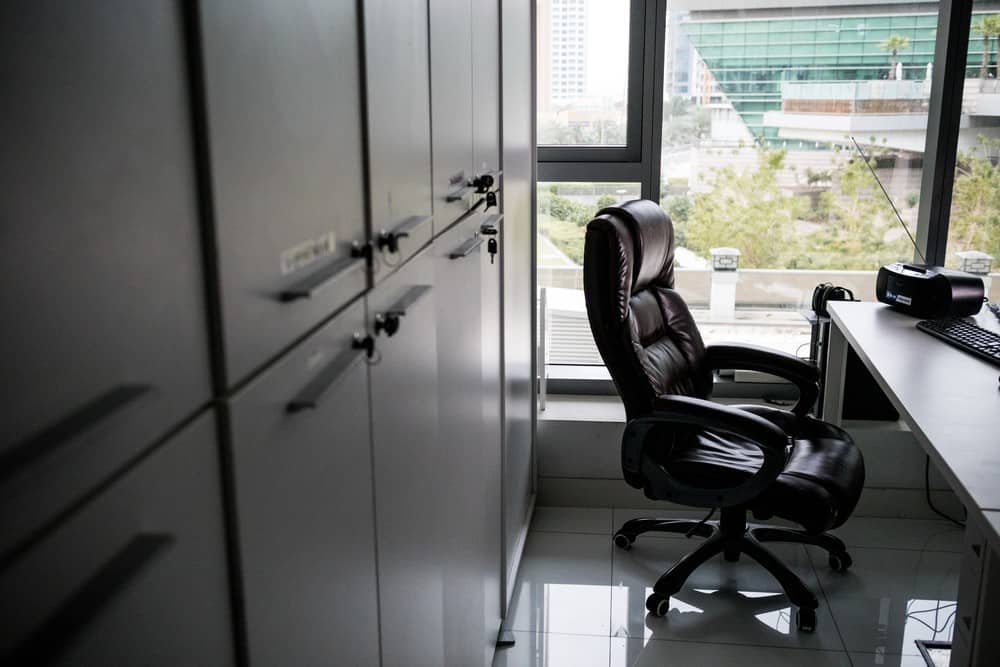
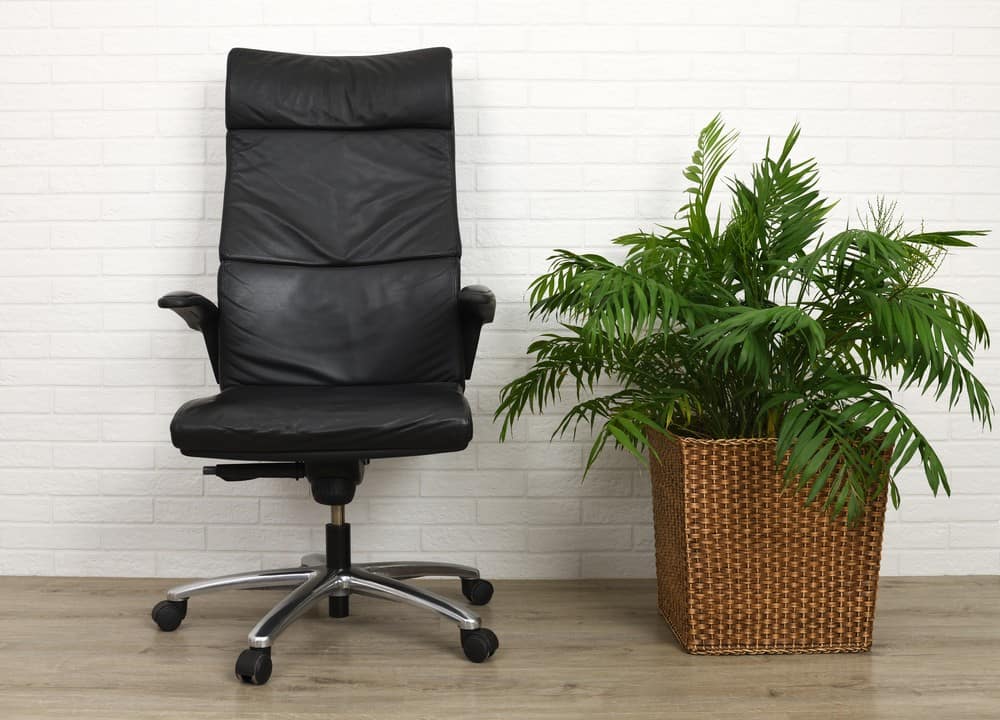

![Best Office Chair in [year] ([month] Reviews) 32 Best Office Chair in 2026 (January Reviews)](https://www.gadgetreview.dev/wp-content/uploads/best-office-chair-image.jpg)
![Best Office Chairs for Sciatica in [year] 33 Best Office Chairs for Sciatica in 2026](https://www.gadgetreview.dev/wp-content/uploads/best-office-chair-for-sciatica-image.jpg)
![Best Chairs for Programmers in [year] 35 Best Chairs for Programmers in 2026](https://www.gadgetreview.dev/wp-content/uploads/best-chair-for-programmers-image.jpg)
![Best Haworth Office Chairs in [year] 36 Best Haworth Office Chairs in 2026](https://www.gadgetreview.dev/wp-content/uploads/best-haworth-office-chairs-image.jpg)
![Best Wooden Office Chairs in [year] 37 Best Wooden Office Chairs in 2026](https://www.gadgetreview.dev/wp-content/uploads/best-wooden-office-chairs-image.jpg)
![Best Humanscale Office Chairs in [year] 38 Best Humanscale Office Chairs in 2026](https://www.gadgetreview.dev/wp-content/uploads/best-humanscale-office-chairs-image.jpg)
![Best Herman Miller Office Chairs in [year] 39 Best Herman Miller Office Chairs in 2026](https://www.gadgetreview.dev/wp-content/uploads/best-herman-miller-office-chairs-image.jpg)
![Best Steelcase Office Chairs in [year] 40 Best Steelcase Office Chairs in 2026](https://www.gadgetreview.dev/wp-content/uploads/best-steelcase-office-chairs-image.jpg)
![Best Leather Office Chairs in [year] 41 Best Leather Office Chairs in 2026](https://www.gadgetreview.dev/wp-content/uploads/best-leather-office-chairs-image.jpg)
![Best Fabric Office Chairs in [year] 42 Best Fabric Office Chairs in 2026](https://www.gadgetreview.dev/wp-content/uploads/best-fabric-office-chairs-image.jpg)
![Best Hon Office Chairs in [year] 43 Best Hon Office Chairs in 2026](https://www.gadgetreview.dev/wp-content/uploads/best-hon-office-chairs.jpg)

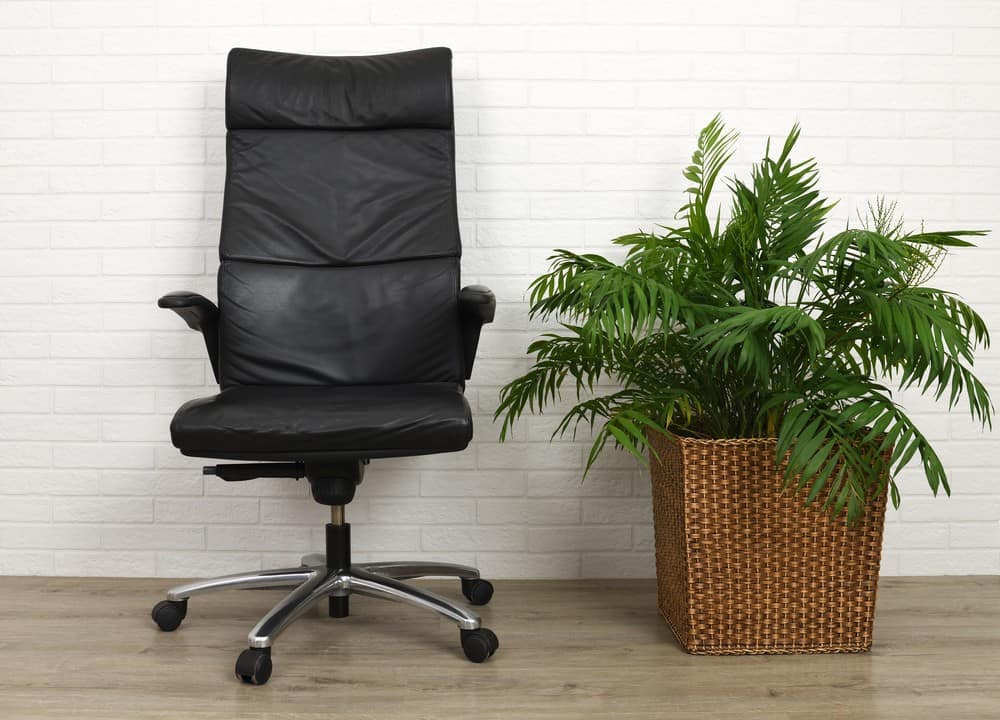
![10 Best Mesh Office Chairs in [year] 46 10 Best Mesh Office Chairs in 2026](https://www.gadgetreview.dev/wp-content/uploads/Best-Mesh-Office-Chair.jpg)
![10 Best High Back Office Chairs in [year] 47 10 Best High Back Office Chairs in 2026](https://www.gadgetreview.dev/wp-content/uploads/Best-High-Back-Office-Chair.jpg)
![10 Best White Office Chairs in [year] 48 10 Best White Office Chairs in 2026](https://www.gadgetreview.dev/wp-content/uploads/Best-White-Office-Chair.jpg)
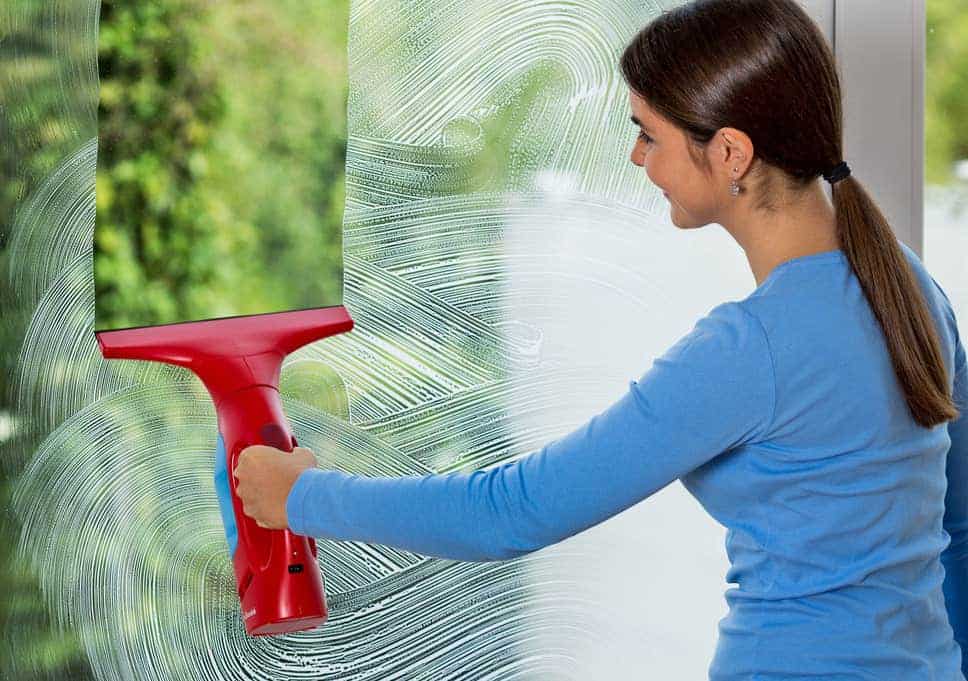
![Best Office Chair Under $300 in [year] ([month] Reviews) 50 Best Office Chair Under $300 in 2026 (January Reviews)](https://www.gadgetreview.dev/wp-content/uploads/chair-lower-back-pain.jpg)
![10 Best Drafting Chairs in [year] 51 10 Best Drafting Chairs in 2026](https://www.gadgetreview.dev/wp-content/uploads/best-drafting-chair.jpg)
